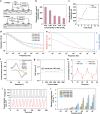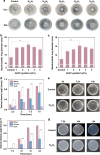A tough semi-dry hydrogel electrode with anti-bacterial properties for long-term repeatable non-invasive EEG acquisition
- PMID: 40419488
- PMCID: PMC12106760
- DOI: 10.1038/s41378-025-00908-4
A tough semi-dry hydrogel electrode with anti-bacterial properties for long-term repeatable non-invasive EEG acquisition
Abstract
Non-invasive brain-computer interfaces (NI-BCIs) have garnered significant attention due to their safety and wide range of applications. However, developing non-invasive electroencephalogram (EEG) electrodes that are highly sensitive, comfortable to wear, and reusable has been challenging due to the limitations of conventional electrodes. Here, we introduce a simple method for fabricating semi-dry hydrogel EEG electrodes with antibacterial properties, enabling long-term, repeatable acquisition of EEG. By utilizing N-acryloyl glycinamide and hydroxypropyltrimethyl ammonium chloride chitosan, we have prepared electrodes that not only possess good mechanical properties (compression modulus 65 kPa) and anti-fatigue properties but also exhibit superior antibacterial properties. These electrodes effectively inhibit the growth of both Gram-negative (E. coli) and Gram-positive (S. epidermidis) bacteria. Furthermore, the hydrogel maintains stable water retention properties, resulting in an average contact impedance of <400 Ω measured over 12 h, and an ionic conductivity of 0.39 mS cm-1. Cytotoxicity and skin irritation tests have confirmed the high biocompatibility of the hydrogel electrodes. In an N170 event-related potential (ERP) test on human volunteers, we successfully captured the expected ERP signal waveform and a high signal-to-noise ratio (20.02 dB), comparable to that of conventional wet electrodes. Moreover, contact impedance on the scalps remained below 100 kΩ for 12 h, while wet electrodes became unable to detect signals after 7-8 h due to dehydration. In summary, our hydrogel electrodes are capable of detecting ERPs over extended periods in an easy-to-use manner with antibacterial properties. This reduces the risk of bacterial infection associated with prolonged reuse and expands the potential of NI-BCIs in daily life.
© 2025. The Author(s).
Conflict of interest statement
Conflict of interest: J.L. and D.W. have filed a patent for the development of the described hydrogel electrodes for EEG acquisition in noninvasive BCI applications. Ethics: This study was approved by the Biological and Medical Ethics Committee of Dalian University of Technology (approval number: DUTSBE250228-09).
Figures






Similar articles
-
Hydrogel electrodes with conductive and substrate-adhesive layers for noninvasive long-term EEG acquisition.Microsyst Nanoeng. 2023 Jun 12;9:79. doi: 10.1038/s41378-023-00524-0. eCollection 2023. Microsyst Nanoeng. 2023. PMID: 37313471 Free PMC article.
-
Polyvinyl alcohol/polyacrylamide double-network hydrogel-based semi-dry electrodes for robust electroencephalography recording at hairy scalp for noninvasive brain-computer interfaces.J Neural Eng. 2023 Mar 17;20(2). doi: 10.1088/1741-2552/acc098. J Neural Eng. 2023. PMID: 36863014
-
Towards real-life EEG applications: novel superporous hydrogel-based semi-dry EEG electrodes enabling automatically 'charge-discharge' electrolyte.J Neural Eng. 2021 Mar 30;18(4). doi: 10.1088/1741-2552/abeeab. J Neural Eng. 2021. PMID: 33721854
-
Review of semi-dry electrodes for EEG recording.J Neural Eng. 2020 Oct 23;17(5):051004. doi: 10.1088/1741-2552/abbd50. J Neural Eng. 2020. PMID: 33002886 Review.
-
State of the Art of Non-Invasive Electrode Materials for Brain-Computer Interface.Micromachines (Basel). 2021 Dec 8;12(12):1521. doi: 10.3390/mi12121521. Micromachines (Basel). 2021. PMID: 34945371 Free PMC article. Review.
References
-
- Al-Saegh, A., Dawwd, S. A. & Abdul-Jabbar, J. M. Deep learning for motor imagery EEG-based classification: a review. Biomed. Signal Process. Control63, 102172 (2021).
-
- Abdulkader, S. N., Atia, A. & Mostafa, M. M. Brain computer interfacing: applications and challenges. Egypt. Inform. J.16, 213–230 (2015).
-
- Bulut, S. The brain–computer interface. Int. Conf. Tech. Technol. Educ.7, 133–138 (2019).
Grants and funding
LinkOut - more resources
Full Text Sources
Miscellaneous
